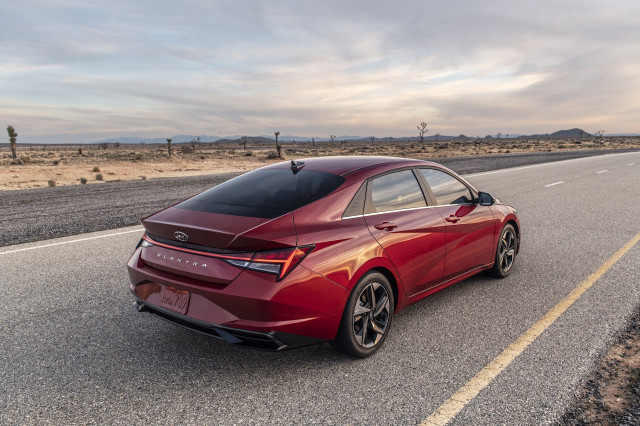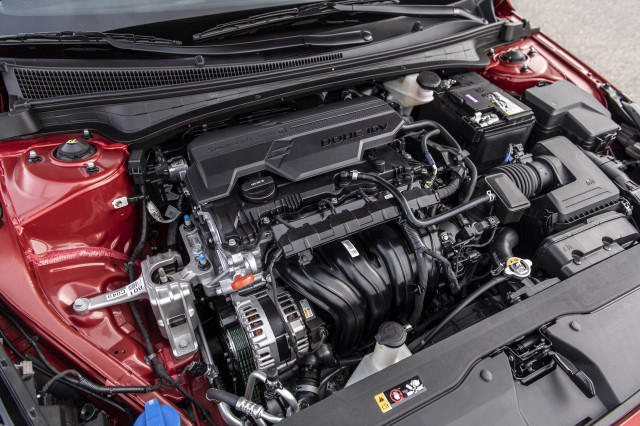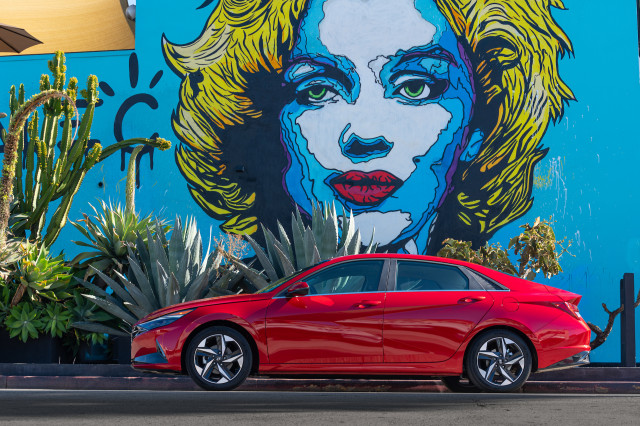LIKES
- Sleek shape
- Hybrid powertrain
- Good rear leg room
- Sporty N editions
- Wireless Apple CarPlay/Android Auto
DISLIKES
- Middling acceleration
- Budget-cutting cabin
- Thinly padded seats
- Rear-seat head room
BUYING TIP
- The Elantra’s standard touchscreen comes with wireless smartphone compatibility, but bigger screens need a cord to run Android Auto and Apple CarPlay.
The 2023 Hyundai Elantra earns its styling stripes and soaring hybrid fuel economy, then lets us down with a drab cabin.
What kind of car is the 2023 Hyundai Elantra? What does it compare to?
A compact four-door with seats for five people, the 2023 Elantra drops a hot styling track and a sharply tuned N edition to cast a deep shadow over cars like the Toyota Corolla and Mazda 3.
Is the 2023 Hyundai Elantra a good car?
With its brash exterior and underbaked cabin, the Elantra puts its best foot forward in looks and economy—until it opens up a turbo howl in Elantra N spec. We give the lineup a TCC Rating of 6.5 out of 10, based on the most popular base version.
What’s new with the 2023 Hyundai Elantra?
The N-Line loses its manual transmission option, while the SEL Convenience package gains the 10.3-inch touchscreen and 17-inch wheels.
Less expensive Elantras tap a 147-hp inline-4 for power, delivering it to the front wheels through a CVT. Good fuel economy offsets its middling power, and the Elantra’s poised ride and decent steering feel get better when a 139-hp hybrid powertrain subs in for the base drivetrain. Hyundai ups the Scoville number with the 201-hp turbo-4 in the Elantra N Line, and goes off the charts with the explosive Elantra N, which rips off 0-60 mph times of about five seconds while it claws the pavement with summer tires, an independent rear suspension, and an 8-speed dual-clutch transmission.
With its nearly mid-size interior space, the Elantra can host up to five people, but the 6-footers in front get the best head and leg room. The back seat’s not wide enough for three full-size people, and the low roofline trims comfort for taller passengers. The cabin’s middling trim grades seem to amplify powertrain noise, too. The Elantra’s 14.2-cubic-foot trunk expands with the rear seats folded down, but utility pales next to the related Tucson crossover.
The Elantra has scored an IIHS Top Safety Pick when equipped with the Limited model’s LED headlights. All models get standard automatic emergency braking, but Hyundai doesn’t offer a surround-view camera system on the Elantra.
How much does the 2023 Hyundai Elantra cost?
It’s $21,545 for an Elantra SE with cloth upholstery, 15-inch wheels, and an 8.0-inch touchscreen with wireless Android Auto and Apple CarPlay. Take the Hybrid Blue for its 54-mpg combined rating and add on Convenience trim for heated front seats, wireless smartphone charging, and digital gauges. It’s more than $33,000 for the spicy Elantra N.
Where is the 2023 Hyundai Elantra made?
In Montgomery, Alabama.
Styling
The interior’s as plain as the body is shredded.
Is the Hyundai Elantra a good-looking car?
With its jet-fighter angles and heavily creased, wasp-waisted body, the exciting Elantra makes for a visual feast that earns two extra points for its dazzling body.
It wears a chamfered, carved look that could come from either a styling star chamber or an elite fitness space, but the Elantra hasn’t been overdesigned. Far from it: it has the kind of signature shape that promises a timeless appeal from its diamond-stamped sides to the stubby rear end’s stickpin-style taillights. In Elantra N drag, it’s even more ostentatious, with front and rear end spoilers that go aggro early.
Performance
The Elantra Hybrid strikes the best balance, while the Elantra N hits a performance triple.
Radical styling cloaks some ordinary performance in the Elantra—at least, in versions without the N at the end of the badge. It sports adequate acceleration for the base versions and above-average ride and handling, for a 5 here. The Elantra N would score a 6, or even higher.
Is the Hyundai Elantra 4WD?
All Elantras have front-wheel drive.
Not very quick, in base spec. A 147-hp 2.0-liter inline-4 powers most low-cost editions and ships its power through a CVT to the front wheels. It works hard, but the payoff isn’t there: the CVT saps the strength, lagging to respond to calls for acceleration even when it’s clicked to Sport mode. Freeway passes require timing and the powertrain generates its share of engine and road noise.
That said, the Elantra handles pretty well, with crisp steering turn-in offsetting some highway-speed wandering. The front strut and rear torsion beam suspension isn’t the stuff of spec-sheet dreams, but it’s tuned here for all-around compliance and works well with 16- and 17-inch wheels that come with mid-range Elantras.
Elantra Hybrid performance
With a more sophisticated rear multi-link suspension, Elantra Hybrids also have a more stable and precise feel. They’re better planted and corner with more confidence, though occasionally the gas-electric powertrain stutters as the engine is clutched in and clutched out as power needs require it.
Elantra N performance
The Elantra N Line takes the Hybrid’s smaller-displacement engine and turbocharges it for a net 201 hp, teamed to a 7-speed dual-clutch transmission. With 0-60 mph times of about seven seconds, the N Line hits a vibrant note. It’s quick, and has the right transmission to respond swiftly to the driver’s inputs, with a blattier exhaust note backing it up.
It handles well, too, outcornering and outgripping all but one of the Elantra family thanks to stiffer springs, an independent rear suspension, and a rear anti-sway bar, not to mention bigger front brake rotors. The ride tightens dramatically without getting upset at minor pavement blisters, and the steering’s hefty and taut, but not unmanageably so. At right around 3,000 lb, the Elantra N Line strikes a great balance between responsive tuning and everyday comfort.
But for the ultimate version of this compact, go for the Elantra N. Its 2.0-liter turbo-4 churns out 276 hp and 289 lb-ft of torque, lighting up the front wheels through either an 8-speed dual-clutch automatic or a 6-speed manual. Automatic models have an “NGS” button that boosts power in short bursts to 286 hp and guns the transmission for even faster shifting; after 20 seconds the spell is broken, and the car needs 40 seconds before it can execute the “N Grin Shift” maneuver once more. Hyundai claims a believable 5.0-second 0-60 mph time for the dual-clutch version, and despite some low-end turbo lag, the Elantra N streams silly power with a very well-mapped shift schedule—the manual’s an afterthought. With a three-mode adjustable set of dampers, an electronic limited-slip differential, and Michelin Pro Pilot Sport 4S summer tires, the Elantra N makes the most of stiffer tuning, quicker steering, and sport bucket seats to breathe new life into the compact-car nameplate.
Comfort & Quality
The Elantra’s amply sized cabin needs finer trim.
The latest Elantra stretches to near mid-size proportions, and has a lower seating position than the last-generation model. Interior space is up, but its seats need better padding and the interior trim looks drab. We give it a 5 for comfort and quality.
A 6-footer fits easily in the Elantra’s front seats, with good head room and a decent driving position. The low seating position makes it more difficult for smaller drivers to find an ideal spot, though. The chairs themselves don’t have much support, their padding feels too thin, and the materials are ordinary on low-spec editions. It’s a step back from the previous Elantra.
With roughly 38 inches of rear-seat leg room, the Elantra can also fit bigger passengers in the two outboard seats, but its sloping roofline cuts into head room. Those seatbacks flip down to expand the 14.2-cubic-foot trunk.
Safety
The Elantra tests well, so far.
How safe is the Hyundai Elantra?
The NHTSA hasn’t re-scored the Elantra yet, but the IIHS gives it a Top Safety Pick in Limited edition, which sports high-quality LED headlights. Other versions are rated “Poor” for headlights.
With its scores and its standard active safety equipment, the Elantra earns a 7 for safety.
Features
The Elantra scores with its plentiful standard features.
Hyundai stocks every Elantra with a wealth of standard features, tips the scales with more options and a ton of value, and caps it with an excellent 5-year/60,000-mile warranty that includes 3 years/36,000 miles of free scheduled maintenance. It’s a 10 here.
Which Hyundai Elantra should I buy?
There’s still not much reason to pay for more Elantra than the $21,545 SE. It has 15-inch wheels, cloth upholstery, power locks and locks, and an 8.0-inch touchscreen with wireless Apple CarPlay and Android Auto.
How much is a fully loaded Hyundai Elantra?
The $27,395 Elantra Limited (Hybrids cost $2,650 more) gains a 10.3-inch touchscreen with cable-required Android Auto and Apple CarPlay, leather upholstery, and adaptive cruise control. Options run from 17-inch wheels to Bose audio, a sunroof, a power driver seat, and an Android smartphone key that takes the place of an actual key.
The $28,095 Elantra N Line takes second place in price tags to the Elantra N, which cost $32,925 for the 2022 model year but hasn’t been priced for 2023 yet.
Fuel Economy
The Hybrid gets the gas-sipping gold star in the Elantra lineup.
Is the Hyundai Elantra good on gas?
With base models turning in EPA ratings of 33 mpg city, 42 highway, 37 combined, the Elantra scores a 5 for fuel economy. At the SEL and Limited end of the spectrum, gas mileage slips to 30/40/34 mpg. Add on a Hybrid system, and ratings soar to 49/52/50 mpg as a Limited or 53/56/54 mpg as the Hybrid Blue.
When things turn fun, the green party ends. The Elantra N Line gets EPA ratings of 28/36/31 mpg, while the Elantra N is rated at 22/31/25 mpg with the manual, 20/30/23 mpg with the dual-clutch transmission.












0 comments:
Post a Comment